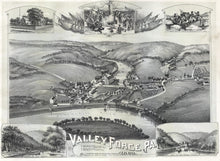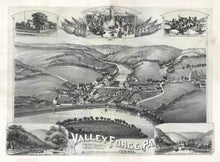T.M. Fowler. “Valley Forge, Pa.”
Myerstown, PA: James B. Moyer, 1890. Two-color Lithograph by A. E. Downs, Boston. 18 7/8 x 26 ¼ (image). Minor staining in margins just into image right hand side. Else, very good condition. Key identifies six historic sites in the village and five vignettes relating to the Revolutionary War and the village surrounding the image. A/A
A fine example of the American bird’s eye view of the nineteenth century. Beginning after the Civil War, the bird’s eye view became one of the most popular of print genre. This was a period of significant urban and rural growth throughout the country, and the civic pride which proliferated provided a fertile field for print publishers to market these visual vistas of American cities and towns. According to John Rep’s seminal Views and Viewmakers of Urban America (Columbia, 1984), publishers sent their artists out into the field throughout all parts of the country to draw and market the views. The artist would walk the streets of the town or city, drawing all the buildings and encouraging the citizens to subscribe to the view that would be produced. Once the entire area was sketched and enough subscriptions obtained, the artist would use a standard projection to turn his street-level images into a bird’s eye view of the town. Because these views were primarily sold to citizens of the place depicted, they had to be accurate and all buildings shown, lest an owner were to be insulted. Thus these views are not only highly decorative, but are also detailed and accurate pictures of each place shown, providing us with a wonderful documentation of nineteenth century urban and rural America.





